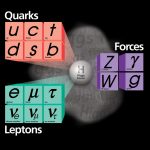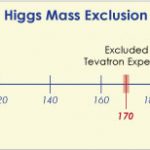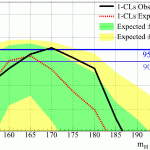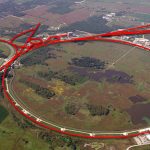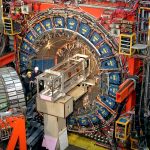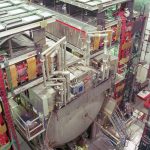Joint CDF, DZero effort lands Fermilab in Higgs territory
Batavia, Ill. — Scientists from the CDF and DZero collaborations at the U.S. Department of Energy’s Fermilab have combined Tevatron data from the two experiments to advance the quest for the long-sought Higgs boson. Their results indicate that Fermilab researchers have for the first time excluded, with 95 percent probability, a mass for the Higgs of 170 GeV. This value lies near the middle of the possible mass range for the particle established by earlier experiments. This result not only restricts the possible masses where the Higgs might lie, but it also demonstrates that the Tevatron experiments are sensitive to potential Higgs signals.
“These results mean that the Tevatron experiments are very much in the game for finding the Higgs,” said Pier Oddone, director of Fermilab.
Combining results from the two collider experiments effectively doubles the data available for analysis by experimenters and allows each experimental group to cross check and confirm the other’s results. In the near future, the Fermilab experimenters expect to test more and more of the available mass range for the Higgs.
The Standard Model of Particles and Forces–the theoretical framework for particle physics–predicts the existence of a particle, the Higgs boson, that interacts with other particles of matter to give them mass. The mechanism by which particles acquire different mass values is unknown, and finding evidence for the existence of the Higgs boson would address this fundamental mystery of nature.
The CDF and DZero experiments each comprise some 600 physicists from universities and laboratories from across the nation and around the world. Currently, Fermilab’s plans call for the Tevatron experiments to continue operating through 2010. In that time, both groups expect to double their analysis data sets, improving their chances to observe the Higgs.
Scientists expect operations to begin at the Large Hadron Collider at CERN, in Europe, sometime later this year. Observation of the Higgs is also a key goal for LHC experiments.
The Tevatron accelerator and the experiments are operating at peak performance. The Tevatron continues to break records for luminosity, the number of high-energy proton-antiproton collisions it produces. The more luminosity the Tevatron delivers, the more chances experimenters have to see the Higgs. Moreover, by continually improving their experimental techniques, the CDF and DZero physicists have been able to boost their sensitivity to the Higgs and other phenomena by more than the margin afforded by the increased data alone.
“The Fermilab collider program is running at full speed,” said Dennis Kovar, associate director of the Office of Science for High Energy Physics at the U.S. Department of Energy. “In the past year alone, the two experiments have produced 77 Ph.D.s and 100 publications that advance the state of our knowledge across the span of particle physics at the energy frontier.”
The new Higgs results are among the approximately 150 results that the two experiments presented at the International Conference on High Energy Physics in Philadelphia held July 29-August 5.
“The discovery of the Higgs boson would answer one of the big questions in physics today,” said Joseph Dehmer, director of the Division of Physics for the National Science Foundation. “We have not heard the last from the Tevatron experiments.”
- According to the Standard Model of particles and forces, the Higgs mechanism gives mass to elementary particles such as electrons and quarks. Its discovery would answer one of the big questions in physics: What is the origin of mass?
- Scientists from the CDF and DZero collaborations at DOE’s Fermilab have combined Tevatron data from their two experiments to increase sensitivity for their search for the Higgs boson. While no Higgs boson has been found yet, the results announced today exclude a mass for the Higgs of 170 GeV/c2 with 95 percent probability (see graphs). This is the first time that the Tevatron experiments directly restrict the Higgs mass. Earlier experiments at the Large Electron-Positron Collider at CERN excluded a Higgs boson with a mass of less than 114 GeV/c2 at 95 percent probability. The results show that CDF and DZero are sensitive to potential Higgs signals. The Fermilab experimenters will test more and more of the available mass range for the Higgs as their experiments record more collision data and as they continue to refine their experimental analyses. The expected exclusion limit (red-dotted line with green and yellow bands in lower graph) will move up as the two collaborations collect and analyze more data.
- Scientists from the CDF and DZero collaborations at DOE’s Fermilab have combined Tevatron data from their two experiments to increase sensitivity for their search for the Higgs boson. While no Higgs boson has been found yet, the results announced today exclude a mass for the Higgs of 170 GeV/c2 with 95 percent probability (see graphs). This is the first time that the Tevatron experiments directly restrict the Higgs mass. Earlier experiments at the Large Electron-Positron Collider at CERN excluded a Higgs boson with a mass of less than 114 GeV/c2 at 95 percent probability. The results show that CDF and DZero are sensitive to potential Higgs signals. The Fermilab experimenters will test more and more of the available mass range for the Higgs as their experiments record more collision data and as they continue to refine their experimental analyses. The expected exclusion limit (red-dotted line with green and yellow bands in lower graph) will move up as the two collaborations collect and analyze more data.
- The Fermilab accelerator complex accelerates protons and antiprotons close to the speed of light. The Tevatron produces millions of proton-antiproton collisions per second, maximizing the chance for discovery. Two experiments, DZero and CDF, search for new types of particles emerging from the collisions.
- The CDF detector, about the size of a 3-story house, weighs about 6,000 tons. Its subsystems record the “debris” emerging from each high-energy proton-antiproton collision produced by the Tevatron. The detector records the path, energy and charge of the particles emerging from the collisions. This information can be used to look for particles emerging from the decay of a short-lived Higgs particle.
- The DZero detector records particles emerging from high-energy proton-antiproton collisions produced by the Tevatron. Tracing the particles back to the center of the collision, scientists understand the subatomic processes that take place at the core of proton-antiproton collisions. Scientists search for the tiny fraction of collisions that might have produced a Higgs boson.
Fermilab, the U.S. Department of Energy’s Fermi National Accelerator Laboratory located near Chicago, operates the Tevatron, the world’s highest-energy particle collider. The Fermi Research Alliance LLC operates Fermilab under a contract with DOE.
CDF is an international experiment of 635 physicists from 63 institutions in 15 countries. DZero is an international experiment conducted by 600 physicists from 90 institutions in 18 countries. Funding for the CDF and DZero experiments comes from DOE’s Office of Science, the National Science Foundation, and a number of international funding agencies.
CDF collaborating institutions are at http://www-cdf.fnal.gov/collaboration/index.html
DZero collaborating institutions are at http://www-d0.fnal.gov/ib/Institutions.html
More information is available in the conference paper at
http://www-d0.fnal.gov/Run2Physics/WWW/results/prelim/HIGGS/H64/




